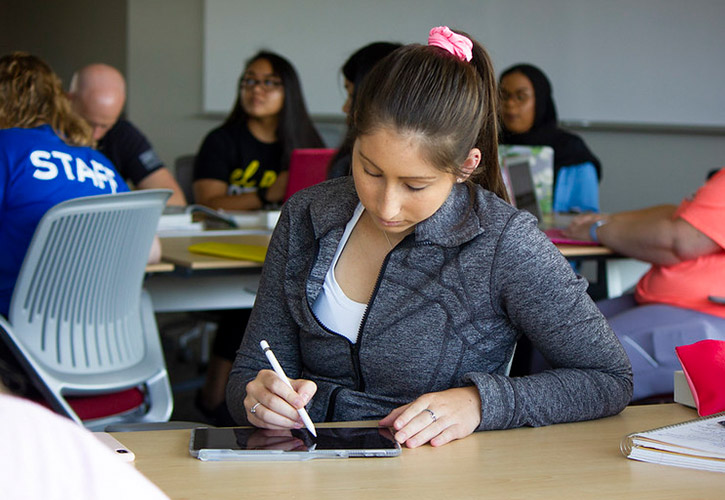Whether you’ve dreamed of being a teacher for a long time or have only recently begun considering the possibility, it’s not too late to pursue a rewarding role as an educator. Those years of experience you’ve gained in another field
are actually an asset to a career in the classroom.
And the good news is you don’t have to start from scratch. A Master of Arts in Teaching (MAT) degree is the perfect path toward pursuing teaching as a second career. This program is designed for aspiring educators who have a bachelor’s degree
in another field.
Learn more about how this advanced education degree can help set you up for success in your future teaching career.
7 Advantages of earning a Master of Arts in Teaching degree
Obtaining a MAT degree will not only prepare you to become a licensed teacher, but also provide you with a variety of skills and other assets along the way. We spoke with Mary
Ann Cahill, Ed.D, the chair of the Master of Arts in Teaching program at Bellarmine University, to discover how your MAT training will benefit you.
1. You’ll be qualified for a rewarding teaching career
While this one may seem obvious, the career opportunities that this degree can unlock should not be overlooked. A second career as a teacher can be extremely rewarding. By combining the professional and personal experiences you already have with the knowledge and training you’ll receive in your MAT program, you’ll be equipped to make a lasting impact in the lives of students every day.
Quality educators are in demand. Employment models predict the nationwide teacher shortage will only worsen, with over 300,000 unfilled teaching positions by 2025, according to research by the Economic Policy Institute.
A lack of qualified teachers means that not only will existing teachers feel increased pressure and stress, but students may receive lower-quality education as a result. And the teacher shortage is prevalent in Kentucky,
as well.
As a licensed teacher, not only will you enter the job market in demand, you’ll have unique advantages as a graduate-degree holder. Dr. Cahill explains that many principals look to hire mature entry-level teachers who are typically better able to navigate professional relationships and challenging situations. Not only do MAT students have more professional experience than the average undergraduate student, but many of them also have kids in school themselves. This means that, as teachers, they’re
able to have more empathy toward the parents of their students.
“Far and away, MAT students are more mature, and that gives them a leg up,” Dr. Cahill states. This is evident in the numbers as well: 97% of Bellarmine MAT graduates
are successfully employed the year after they graduate.

2. You’ll build confidence in your career
Not only will you be prepared to become a state-licensed teacher, but an MAT degree will also help you establish the confidence you’ll need to lead your own classroom. You’ll learn the foundations and history of education in the United States, study
classroom management models, develop your classroom management skills and practice using technology in the classroom.
In addition to taking education-focused courses, you’ll also develop expertise in whatever content you’ll be teaching. Elementary teachers need to have a broad knowledge of many subjects from literature, reading and writing methods to history,
math and science. Middle and high school teachers with a content certification may need to take more classes in that discipline, depending on their undergraduate degree.
In addition to the knowledge you’ll gain through classes and studying, you’ll also strengthen the characteristics required of teachers: patience, observational skills, personal responsibility and self-awareness. The MAT curriculum at Bellarmine
is designed to develop these proficiencies.
Beyond the courses themselves, Bellarmine MAT students are required to obtain 200 field hours in Kentucky before their student teaching semester. Bellarmine places students in a variety of classrooms for about 55 hours per semester. This invaluable experience
allows you to learn from a variety of mentor educators, giving you a glimpse into your future in teaching.
“These hours make a big difference in your confidence and your ability to really understand the reality of teaching,” Dr.
Cahill adds.
3. You’ll be prepared to use technology to your advantage
Technology has become vital in the classroom—in both virtual and traditional settings. Teachers must be well-equipped to lead their students via learning management systems, video calls and various communication tools no matter what the circumstances.
“A good teacher is able to think on their feet and adapt the lesson as dynamics change,” Dr. Cahill explains. “We try to build adaptability and the ability to learn new technologies into all of our courses. It’s an integral part
of being a good teacher.”
Bellarmine MAT students are prepared to use technology for teaching throughout the entire program. They take a course that specifically aims to empower students to use technology confidently in both virtual and traditional classrooms.
In the “Computer Applications in Education” course, not only do students learn about the benefits of technology integration, they also study the barriers that students might encounter, including lack of equity in the access to and use of technology.
The course also covers different learning management systems, communication and assessment tools, videoconferencing platforms, instructional apps and more.
Aside from this course, MAT students are able to complete their student teaching semester
virtually if the school they are assigned has moved to non-traditional instruction. Student teachers work closely with their mentors to provide instruction via technology using and skills they’ve gained in their previous courses. “One of the
benefits of our program is the focus on flexibility and culturally-responsive teaching,” Cahill adds.
4. You’ll be equipped to teach a diverse student population
While this is an especially popular talking point in the current education landscape, the ability to educate students with a wide range of abilities and backgrounds will always be a critical skill for teachers. Throughout their program, MAT students are trained in a variety of ways to teach a diverse range of students in their future classrooms.
At Bellarmine University, MAT students study these tactics in a course called “Teaching Diverse Populations.” This course focuses on students with varied cultural backgrounds and diverse abilities, including students enrolled in special education programs. MAT students also learn “culturally-responsive pedagogy,” a teaching methodology that helps them develop an understanding of their own privilege and how to mitigate potential equity issues in the classroom.
MAT students
put everything they learn in the classroom into practice by completing field hours in a variety of classroom settings, from urban to rural and private to public, so they gain experience with a diverse population of students. Bellarmine students also have
an opportunity to study abroad during their student-teaching semester, allowing exposure to new cultural contexts and expanding their skillsets.
5. You’ll learn how to leverage data in the classroom
Not only do MAT students become excellent teachers, they also learn how to use data to keep getting better. Collecting and evaluating data can enable teachers to learn more about their students and their students’ needs. This can help them adapt their lesson plans and get the support they need from their school administration and district. For teachers, data is critical. This can include data from assessments including casual check-ins, measuring post-lesson outcomes, or formal tests and quizzes. “To me, teaching without assessment is irresponsible,” Dr. Cahill says.
Bellarmine MAT students take a course called “Research Methodologies” where they learn how to properly evaluate statistics. MAT students design an action research project that asks a question, sets up an experiment and gathers data to find
the answer.
Data collection is also built into each lesson plan that Bellarmine students develop. At the end of each lesson, MAT students are expected to have what’s called a ‘formative assessment’ that measures specific objectives. In addition,
they create a plan for those who didn’t quite grasp the concept.
All this prepares them for the classroom, where they’ll be constantly gathering data and using it to benefit and advocate for their students and enhance learning.
“As a teacher, every day – maybe eight times a day – you’ll pick up little pieces of data that give you information on the students and their learning,” Dr. Cahill explains.

6. You’ll establish a specialty area you’re passionate about
Many MAT students enter into the program knowing the age range they’d like to teach: elementary, middle, or high school. But what’s more, MAT students interested in teaching middle or high school can gain a competitive edge by pursuing dual or secondary certification in a content area like biology, chemistry,
mathematics, physics or social studies.
Teachers with content certifications are in such high demand that these MAT students often get hired and begin work as an alternative certification teacher even before graduating. In other words, MAT students who meet a handful of requirements are permitted to be hired prior to completing the entire MAT program.
The added stress of moving into an alternative certification position while still in school isn’t for everyone, but it can be an amazing way to jumpstart your teaching career and get paid as a teacher while earning your Master of Arts in Teaching.
7. You’ll have increased earning potential
As a graduate degree-holding teacher, you have the potential to earn a higher starting salary than you would as a new teacher with a bachelor’s degree. Though starting salary varies depending on each school district, teachers are often paid
on a scale according to their experience and education.
“Students walking into a job with a master’s degree and a teaching certification will automatically put them at a higher initial salary than new teachers with their undergraduate degree,” Dr. Cahill explains. You’ll also have a
head start on any future advancement opportunities you may be interested in later in your career, which may also positively impact your compensation.
Find success in your second career
Going back to school is a big step, but earning your Master of Arts in Teaching is certainly worth it. And no matter where you are in life, it’s not too late.
“If you’re not happy in what you’re doing and you’ve considered becoming a teacher, know that it’s not an easy job, but it gives back so much,” Dr. Cahill shares. “It’s never too late to make a difference
in a child’s life.”
If you’re ready to make an impact, visit the Bellarmine University Master of Arts in Teaching program page to learn more about the training you’ll need to succeed.
Whether you’ve dreamed of being a teacher for a long time or have only recently begun considering the possibility, it’s not too late to pursue a rewarding role as an educator. Those years of experience you’ve gained in another field
are actually an asset to a career in the classroom.
And the good news is you don’t have to start from scratch. A Master of Arts in Teaching (MAT) degree is the perfect path toward pursuing teaching as a second career. This program is designed for aspiring educators who have a bachelor’s degree
in another field.
Learn more about how this advanced education degree can help set you up for success in your future teaching career.